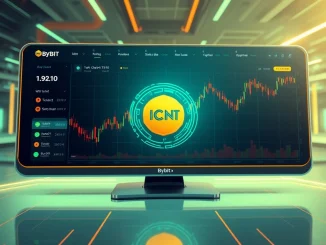
In a truly groundbreaking move that could redefine corporate finance, Nature’s Miracle Holding Inc., a leading U.S.-based vertical farming technology company, has made headlines by allocating up to $20 million of its corporate treasury to XRP. This isn’t just another crypto investment; it marks a significant milestone, positioning Nature’s Miracle as one of the first publicly traded U.S. entities to embrace XRP on such a substantial scale. What does this strategic pivot mean for the future of corporate crypto adoption and the broader digital asset landscape?
What’s Driving Nature’s Miracle’s Strategic XRP Investment?
The decision by Nature’s Miracle to commit a significant portion of its corporate treasury to XRP is a bold statement, signaling a deep belief in the asset’s utility and the underlying blockchain technology. Announced alongside an SEC-approved equity financing agreement with GHS Investments, this move allows the company to dynamically acquire XRP by selling shares at market prices. CEO James Li highlighted the core motivations behind this strategic pivot:
- Enhanced Financial Efficiency: Li emphasized XRP’s low transaction fees and rapid settlement times as significant advantages over traditional financial systems. This efficiency can translate directly into cost savings for the company’s operations.
- Strategic Utility: The company plans to leverage XRP for staking, liquidity management, and potential integration into RippleNet’s cross-border payment network. This multifaceted approach goes beyond simple holding, aiming to derive active value from the asset.
- Regulatory Clarity: Li linked the initiative to the recent passage of the U.S. GENIUS Act, which he described as providing the necessary regulatory clarity to encourage crypto adoption among corporations. This suggests a more confident environment for such investments.
Unlike firms like MicroStrategy, which have largely focused on Bitcoin as a reserve asset, Nature’s Miracle‘s focus on XRP aligns with its role in institutional finance and cross-border transactions, particularly within Ripple’s ecosystem. This distinct approach highlights a broader shift in corporate treasury strategies, where assets are chosen not just for speculative value, but for their functional advantages.
The Strategic Shift: Why an XRP Treasury?
The allocation to an XRP treasury reflects a sophisticated understanding of digital assets beyond simple speculation. Nature’s Miracle’s strategy is rooted in leveraging XRP’s inherent design for speed, cost-efficiency, and institutional adoption. Here’s why XRP is gaining traction as a reserve asset for forward-thinking companies:
- Cross-Border Payments: XRP is purpose-built for efficient international transactions. Its ability to settle payments in seconds, rather than days, and at a fraction of the cost of traditional banking rails, makes it highly attractive for businesses with global operations. Major institutions like Banco Santander and American Express already utilize XRP for such purposes.
- Liquidity and Market Float Reduction: By integrating XRP into its treasury management, Nature’s Miracle aims to enhance liquidity and potentially reduce market float. This indicates a proactive approach to optimizing the company’s financial health and capital structure.
- Yield Generation through Staking: The company’s decision to stake its XRP holdings for yield generation further underscores its confidence in the asset’s long-term utility and value proposition. This allows them to earn passive income on their holdings, adding another layer of financial benefit.
This approach diverges from traditional corporate crypto holdings by prioritizing XRP’s functional advantages in global finance. It’s about integrating the asset into the company’s operational and financial framework, rather than merely holding it as a store of value.
Pioneering Corporate Crypto Adoption: A New Era?
Nature’s Miracle‘s bold move positions it as a pioneer in the realm of corporate crypto adoption. This isn’t just a singular event; it signals a larger trend of corporate diversification into digital assets, driven by increasing regulatory clarity and improved compliance frameworks. As a leader in vertical farming and controlled environment agriculture, the company’s pivot into XRP reflects a reimagining of blockchain technology as both a technological and financial tool.
The market’s initial reaction has been positive, with XRP’s price remaining above $3 in the days following the disclosure. Analysts suggest that such high-profile allocations could influence other companies to explore crypto reserves within regulated frameworks. This initiative highlights:
- The growing institutional interest in XRP and its proven utility in financial infrastructure.
- The potential for other corporations to consider similar strategies, particularly in sectors requiring rapid, low-cost transactions.
- A shift towards viewing cryptocurrencies not just as speculative assets, but as strategic components of corporate treasury management.
Implications for Public Company Crypto Holdings
The decision by Nature’s Miracle has significant implications for how other public company crypto holdings might evolve. For years, MicroStrategy stood out as the primary example of a publicly traded company heavily invested in cryptocurrency, primarily Bitcoin. However, Nature’s Miracle’s strategy offers a new blueprint:
- Diversification Beyond Bitcoin: It demonstrates that corporate treasury strategies can look beyond Bitcoin and explore other cryptocurrencies that offer specific functional advantages, like XRP’s role in cross-border payments.
- Utility-Driven Investments: This move emphasizes utility over pure price appreciation. Companies might increasingly look for digital assets that can integrate into their operations, reduce costs, or generate yield.
- Regulatory Confidence: The comfort with which Nature’s Miracle made this announcement, citing the GENIUS Act, suggests that a clearer regulatory environment can significantly de-risk crypto investments for publicly traded entities.
If this trend continues, we could see a broader adoption of various digital assets by public companies, each selected for specific strategic advantages relevant to their business models. This would mark a maturation of the crypto market and its integration into traditional finance.
What Does This Mean for XRP’s Future and Utility?
Nature’s Miracle‘s substantial investment provides a powerful endorsement for XRP, reinforcing its position within Ripple’s ecosystem as a viable alternative to legacy financial systems. This allocation is a testament to the rising institutional confidence in XRP‘s potential to streamline cross-border payments and reduce operational costs. If XRP’s utility continues to expand and gain traction, this firm could set a significant precedent for other corporations considering similar strategies, particularly those in global trade, logistics, or any sector requiring rapid, low-cost transactions.
This strategic allocation positions XRP as a strategic reserve for forward-thinking firms, potentially accelerating its mainstream adoption and solidifying its role in the global financial infrastructure. It’s a compelling narrative for XRP’s future, moving beyond speculative trading to practical, institutional-grade utility.
A New Horizon for Corporate Finance
Nature’s Miracle’s audacious move to integrate XRP into its corporate treasury is more than just an investment; it’s a powerful statement about the evolving role of digital assets in mainstream finance. By leveraging XRP’s unique advantages for cross-border payments, liquidity, and yield generation, Nature’s Miracle is not only optimizing its own financial operations but also setting a compelling precedent for other publicly traded companies. This strategic allocation underscores a growing confidence in XRP’s utility and the broader blockchain ecosystem, signaling a potential paradigm shift in how corporations manage their reserves and conduct global transactions. As regulatory clarity improves and institutional adoption accelerates, Nature’s Miracle’s pioneering step could mark the beginning of a new chapter for corporate crypto integration.
Frequently Asked Questions (FAQs)
1. What is Nature’s Miracle Holding Inc.?
Nature’s Miracle Holding Inc. is a U.S.-based vertical farming technology company. They specialize in controlled environment agriculture, providing innovative solutions for modern farming.
2. Why did Nature’s Miracle choose XRP for its treasury?
Nature’s Miracle chose XRP due to its low transaction fees, rapid settlement times, and potential for staking to generate yield. They also see its utility for liquidity management and integration into RippleNet for cross-border payments, aligning with their goal of enhancing financial efficiency.
3. How does this compare to other corporate crypto investments?
Unlike companies like MicroStrategy, which primarily invest in Bitcoin as a store of value, Nature’s Miracle’s investment in XRP is more focused on its functional utility for institutional finance and cross-border transactions. It’s a strategic move to integrate a digital asset into their operational treasury management rather than just holding it as a reserve.
4. What is the U.S. GENIUS Act mentioned in the article?
The article mentions the U.S. GENIUS Act as providing regulatory clarity that encouraged crypto adoption among corporations. While the specific details of this act aren’t elaborated upon in the provided text, its mention implies a legislative framework that supports corporate engagement with digital assets.
5. What are the potential implications for XRP’s price and adoption?
High-profile allocations like Nature’s Miracle’s can boost market sentiment and institutional confidence in XRP. This could potentially lead to increased adoption by other corporations, further integrating XRP into global financial infrastructure and potentially influencing its long-term value and utility.
6. How does staking XRP benefit Nature’s Miracle?
By staking its XRP holdings, Nature’s Miracle can generate passive income or yield on its investment. This adds another layer of financial benefit to holding the asset, demonstrating confidence in its long-term utility and providing a return on their treasury allocation.



